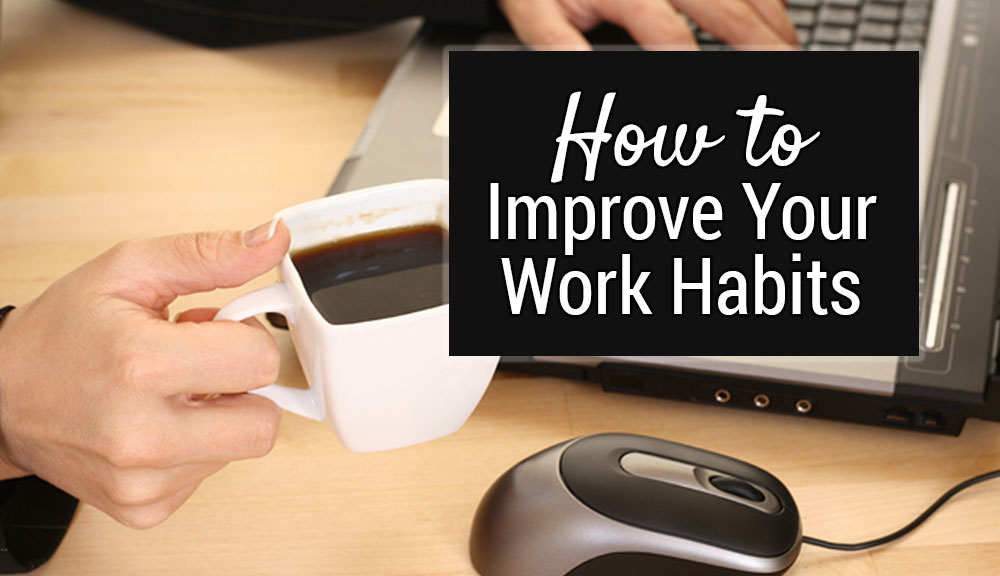
When you work alone, good work habits can make or break your success.
I’ve been a self-employed writer for 10 years now, and during this time running an online business, I’ve learned things about myself and how I work.
Being self-employed takes some different skills and determination to stay on task vs. working for an employer, and that can make it challenging to figure out how to be successful at work without a boss telling you what to do.
I’ve found it very useful to be aware of what works for me and what doesn’t. So pay attention to those things that improve your work and those things that don’t. These things can apply to people who are self-employed doing all kinds of different things: freelancing, blogging, affiliate marketing, ecommerce, and more.
Here are a few of the things about my work habits and abilities that I’ve noticed over the years that might help you figure out how to improve your own work habits.
Examples of Good Work Habits
Know if you’re a morning bird or a night owl.
I’m a morning person and do my best work and writing in the mornings. I have energy, enthusiasm, and more focus in the mornings, but at night I am sluggish, tired, and irritable. I’ve learned that it’s best to get up early and start to work instead of procrastinating and waiting to do work later in the day.
My work is always better and I get a lot more done in the mornings. On the other hand, I have friends/family members who do their best work at night and are sluggish and have trouble focusing in the morning.
Tip: Be aware of which time of the day works best for you (unless you’re able to work either end of the candle) and then make an effort to do most of your work during those times.
Figure out if you prefer working toward large long term goals, or breaking things up into smaller milestones.
I’ve found that I work best when I pick one piece or task to work on at a time. I do not do well on large, long-term projects (like a big cross-stitch pattern) but I do much better on smaller projects (like making a necklace or pair of earrings). This is the same with writing.
If I focus on getting a ton of things done at one time I get lost and overwhelmed which lessens my confidence and motivation. But if I focus on one area that I can easily get done in a short period of time then it’s much easier for me to complete the task and feel good about it.
Tip: See the big picture but work on one piece at a time.
Learn to “just do it”
I’ve found that the hardest part for me when creating an article, blog post, or any other project for that matter, is getting started. Once I start something, my drive to complete the task kicks in and I almost always finish whatever it was that I started.
I get a real sense of satisfaction from my work once it’s complete. I like to take a few minutes to look over and enjoy what I’ve accomplished. Thus, I’ve learned to “Just Do It” and start working on something; after that the rest falls into place. It may sound simple, but it’s the hardest part for me.
Tip: Which part of a project do you struggle the most with? Getting started, sticking with it, or finishing? Be aware of how you work and focus your efforts on completing those areas you struggle with the most.
Understand your cognitive style
 To understand how to get more work done, it helps to understand your own individual cognitive style.
To understand how to get more work done, it helps to understand your own individual cognitive style.
I’m much more left-brained (analytical) than right-brained (creative), but I’ve learned I need to allow each side to participate in the process to create proper balance with my work.
Although I like to have order, I’ve found that I must first allow my creative side to have control while writing an article and then I can let my organized side go through and edit/fix things.
This means that instead of writing from the top of the article to the bottom, I bounce all over the place…
Sometimes I just start writing a paragraph that will be in the middle of the article, then I bounce over to find an image I want to use. From there I hop over to get a link I need, then I’m back to writing another section or two. At this point, I put together the meta data, then I’m inserting more links, then back to more writing, then add a title, etc.
It’s crazy to watch how I write and work and it doesn’t exactly make sense, but I’m able to keep track of everything. I know what I’ve already done and what still needs to be completed. I can even leave sentences incomplete and come back to them later.
Do what works for you (not just what everyone else does)
So instead of using an outline, I just get started and everything falls into place. After I’m done, I preview the article, read through it, fix errors or add/remove content until I’m satisfied.
I’ve learned that if I allow some chaos into my writing I am much happier with the overall process. Also, the final outcome of my writing is far better than when I try to force myself to work from an outline or in a specific order.
Tip: We each use both sides of our brains but usually one side is more dominant than the other. It’s helpful to pay attention to how you feel/react when working and recognize what techniques work best for you and your personality.
Do you work best when you start from an outline and go from beginning to end? If you feel that you’re forcing yourself to do something then maybe it’s not the best way you work. Try relaxing a little and let yourself find what method works best for you to feel good and productive.
Take breaks away from the computer
 This is one of the hardest tips for me. It’s so easy to take a break or eat my lunch while at the computer, but it’s better for my overall health (physical, mental, emotional) to step away from the computer and go do something else.
This is one of the hardest tips for me. It’s so easy to take a break or eat my lunch while at the computer, but it’s better for my overall health (physical, mental, emotional) to step away from the computer and go do something else.
Your “creative bucket” needs to be regularly filled and added to because, as you work, you are taking “juice” from your bucket.
There are so many ways to refill your tank too…
Go for a walk, read a real book or magazine, take a nap, work out at the gym or take a class, go shopping, visit a park or museum. Whatever you do, get away now and then.
I take a kickboxing class twice a week and I love it! I enjoy walks, reading, and making jewelry. Doing other creative, active, and fun things really rejuvenates me.
Tip: Get out of the house and do something by yourself or with someone else. Be aware of when you’re feeling depleted and worn down. When you are, step away from the computer and take a break.
Even a small one can help refresh your work, but if that doesn’t help it’s time to take a longer break. For those of us who are glued to our monitors it’s important to regularly add other joys into our daily routine.
When you’re stuck, go work on something fun
Through the years I’ve also found that when I’m feeling stuck and am resisting getting to work, then I need to focus on something fun with my business. This usually involves something a little more creative on my site, such as working with images, personal stories (ones that can be shared of course), charts, graphs, puzzles, or other visual resources.
Tip: When you’re working, notice those things that spark your interest, make note of them, and then come back to them when you are feeling stuck, bored, or unresponsive.
Figure out if you prefer sounds or silence
 Although I can easily block out white-noise, it’s much harder for me to concentrate on my work when there is a lot of noise – specifically, music, TV, games, or talking.
Although I can easily block out white-noise, it’s much harder for me to concentrate on my work when there is a lot of noise – specifically, music, TV, games, or talking.
I can’t work for very long if there is music of any kind playing, even if it’s soft or classical. I’ve found that I quickly become irritated because I can’t think, I can’t focus, and I can’t concentrate.
It may be odd, since many people work much better with music playing, but I’ve learned that I can’t relax and enjoy my work because the music distracts me. The same with TV, computer games, or talking.
If my family is watching TV or playing games there is no way I will be able to effectively work. It’s best to either do my work elsewhere or take a break and join in on the fun.
Tip: Monitor your progress when working with music, TV, or other background noise. Does your work improve or do you become distracted?
Examples of bad work habits
We’ve talked about some good work habits you can develop, most of which hinge on understanding your own personality, how you think, and under what conditions you can get the most done.
But issues with productivity may not always stem from an absence of good habits. You also need to identify and eliminate any bad work habits you’ve been stuck in.
Overworking yourself
 Everyone has limits. For motivated people with ambition — like most solopreneurs — it’s natural to want to push against those limits.
Everyone has limits. For motivated people with ambition — like most solopreneurs — it’s natural to want to push against those limits.
But it’s all too easy to burn yourself out. You have to pace yourself. Sure, crunch times happen. That’s just life. But if you’re constantly overworked, overstressed, and exhausted, you probably have too much on your plate.
It’s okay to step back and pare things down. You’d be surprised at how many entrepreneurial failure stories have burnout as the root cause.
Putting things off until the last minute
Procrastination just leads to more stress, as you rush to get everything done in time with the clock ticking. Try dividing things up into smaller milestones. That way, a large project won’t seem as daunting, and you can make sure you have the time to get it done.
Good work habits stem from self-awareness
- Observe yourself, your work habits, and writing process.
- Determine how you work and which techniques and situations support your writing.
- Use what works and discard what doesn’t.
- Enjoy what you do!
Want more articles like this delivered directly to your inbox? Sign up for our newsletter!


Latest posts by Rachel Bruner (see all)
- How to Develop Good Work Habits: A Simple Guide for Busy Solopreneurs - October 7, 2019

